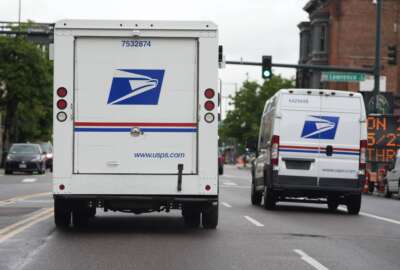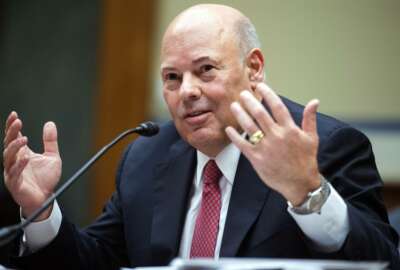

The Postal Service, a longtime supporting player in voting thrust into the spotlight since its major role in the 2020 election, may get some additional support ...
The Postal Service, a longtime supporting player in voting thrust into the spotlight since its major role in the 2020 election, may get some additional support from a bill that’s headed for a House floor vote.
The House Oversight and Reform Committee on Thursday passed the Vote by Mail Tracking Act, which would require states to include a scannable barcode on all mail-in ballots for federal elections.
Committee Chairwoman Carolyn Maloney (D-N.Y.) said her bill would implement a recommendation from the Postal Service’s watchdog office, and would allow voters to ensure their ballots have been received and counted.
“Given the increase in the use of mail-in ballots in recent years, it is important to ensure that election officials and voters can track ballots once they’re in the custody of the Postal Service,” Maloney said. “I can tell you that during the past election and in 2020, we got hundreds of phone calls from people trying to track their ballots. They wanted to make sure their ballots were cast and recorded, and this would allow them to do that.”
The committee approved the bill with a bipartisan 34-5 vote, with several of the committee’s top Republicans endorsing the legislation.
“I actually like this bill,” Committee Ranking Member James Comer (R-Ky.) said. “That’s been a huge issue in a lot of elections over the past four years — that is, the envelopes carrying such ballots must include a barcode that can be read by Postal Service equipment.”
“This is an important step to ensure elections are conducted fairly. Another important benefit of this legislation is it will help protect the Postal Service from being blamed for election irregularities,” Comer added.
It remains unclear whether the legislation can pass through the House and Senate before the end of this session of Congress, and if not, whether it will be reintroduced and pass through a Republican-majority House starting in January.
An earlier version of the bill would have reimbursed state governments for the cost of implementing barcodes of mail-in ballots, but lawmakers stripped that provision from the bill that passed.
Comer said he applauded Maloney’s decision to remove the reimbursement language.
“I do not support having the federal government reimburse states and local election jurisdictions for the cost of using barcodes. If states make the decision to expand voting by mail, they need to be prepared to cover the associated cost, if they want to utilize a federal institution like the Postal Service,” Comer said.
Rep. Scott Franklin (R-Fla.) agreed that states that decide to implement mail-in voting should be responsible for bearing the cost of meeting all statutory requirements.
“I do recognize that by the federal government not paying for the tracking, that forces an unfunded mandate down to the state and local level. But candidly, in this case, I think that’s a good thing … The way states conduct their elections should rest with them and not the federal government. So that’s their choice. But for the state who have decided to send ballots out to every single person, whether they’ve asked for him or not, I think that’s a state choice. And if they’ve chosen to do that, then they should bear the costs,” Franklin said.
The legislation fulfills a recommendation from the USPS inspector general’s office to include scannable barcodes on all mail-in ballots for the 2020 election.
“We saw how important the Postal Service became in that critical election and continues to be in this midterm,” USPS Inspector General Tammy Hull told the government operations subcommittee on Wednesday.
USPS has been getting more ballots with barcodes since the 2020 election, even without legislation requiring it.
Hull said 53% of the ballots USPS received in the 2020 election had barcodes, and 83% of ballots mailed in this year’s primary election had barcodes.
“It really gives a great tool to track where those ballots are in the system, if barcodes are included. It’s a challenge, because of the number of election offices that are involved in preparing ballots, and the Postal Service is obviously not in control of that,” she said.
The USPS IG’s office is wrapping up its review of USPS’ performance in delivering mail-in ballots for the 2022 midterm election. The final report will be released in early 2023.
In preparation for this report, the IG’s office conducted more than 800 observations at postal facilities covering all 50 states, Washington, D.C. and Puerto Rico between October and November.
Edmund Carley, national president of United Postmasters of America, said the legislation would provide additional trust and transparency in USPS, which has gone to extraordinary lengths to deliver mail-in ballots on time.
“There is no standardized product for mail-in ballots. We do extraordinary measures,” Carley said.
Among those measures, Carley said USPS has been bringing in the mail from blue collection boxes on Sundays, to ensure mailed-in ballots get delivered the following Monday.
“We go above and beyond, so I’m very interested in a specific product that we could then mark it to, to the county seats and the people that do the actual elections because it’s all different,” he said.
The legislation doesn’t require any state to expand vote by mail. Since the 1980s, states make the decision of whether or not they vote by mail, every state now offers some type of vote by mail.
“I’m not an expert on ballot design,” National Postal Mail Handlers Union President Paul Hogrogian told the subcommittee on Wednesday. “But if it makes it more efficient to process it, I’m all in favor of it. But that being said, no matter how you mail the ballot, you mail it, we will move it.”
Rep. Andy Biggs (R-Ariz.) said he also supports the legislation, but also called for voter identification measures
“I appreciate the effort that has gone into this bill, because if you’re going to do mail-in balloting, we certainly should be tracking those ballots,” Biggs said.
Subcommittee Ranking Member Jody Hice (R-Ga.) noted USPS has received bipartisan praise for its handling of a record number of mail-in ballots in recent elections, despite some criticism of operations changes made by Postmaster General Louis DeJoy.
A federal judge in October ruled that USPS policy changes, including a decision by DeJoy to limit late and extra truck trips between mail processing plants and post office, were the “primary factor” that reduced mail service ahead of the 2020 election.
Nevertheless, USPS says it delivered 99.89% of ballots in 2020 to election officials within seven days, its minimum mailing time recommendation to voters, and that 97.9% of ballots arrived within three days. On average, it took 1.6 days for ballots to arrive at election boards.
“The Postal Service delivered in that election, both literally and figuratively. And if this election that we’re currently involved in — frankly, if it ever wraps up — I believe we will learn how well the Postal Service did this time around as well. I’m given to understand Mr. DeJoy acknowledges his attempts to get the trucks running on time did not work, and that he does not want to repeat that mistake. Well, that’s what leaders do. They try they act they acknowledge their mistakes,” Hice said.
Copyright © 2024 Federal News Network. All rights reserved. This website is not intended for users located within the European Economic Area.
Jory Heckman is a reporter at Federal News Network covering U.S. Postal Service, IRS, big data and technology issues.
Follow @jheckmanWFED



